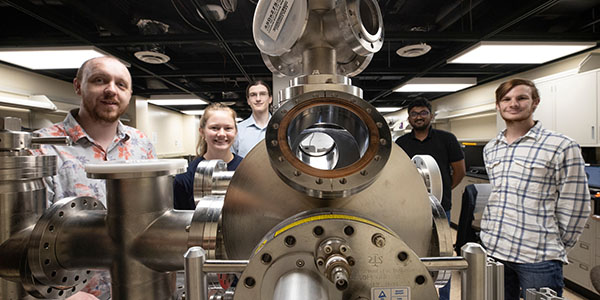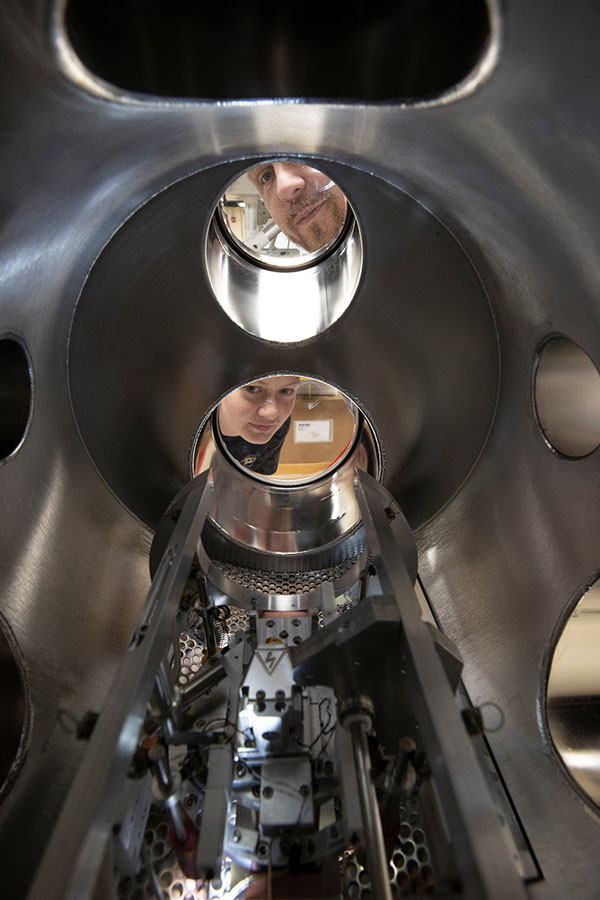‘All about resolution’ when it comes to donated STM
Microscope part of educational partnership agreement between Miami and Air Force Research Laboratory

‘All about resolution’ when it comes to donated STM
When Nate Price first heard Miami University would soon receive an ultra-high vacuum scanning tunneling microscope (UHV STM), he immediately saw the possibilities.
Price, entering his second year as a master’s student studying Physics at Miami, has a background working with STMs as an undergraduate at Brown University.
So, too, does Perry Corbett, an assistant professor of Physics who has retrofitted one STM and repaired another. Corbett worked for the scientific research and technology company UES Inc. in conjunction with the Materials and Manufacturing Division of the Air Force Research Laboratory (AFRL), the division that donated the STM to Miami through an educational partnership agreement.

By utilizing this new-to-Miami microscope, Corbett, Price, Lakshan Don Manuwelge Don, and their colleagues will be able to map a sample’s surface atom by atom using ultra-high resolution. Corbett is in the process of modifying the STM to give it advanced capabilities, including adding a magnetic field as well as an additional chamber, which will allow Corbett’s group to bring in samples from collaborators across the world.
With a lab full of custom equipment, Corbett has a knack for building stuff – especially STMs. He can assemble them from scratch, draw a diagram from memory, or take them apart, screw by screw.
“The microscope was in fantastic condition,” Corbett said of the model that had been with the AFRL for about 12 years. “I had the tools in my toolbox to bring it back to life at Miami.”
Price, from Edinboro, Pennsylvania, and a member of Miami’s cross country and track and field teams, is more than happy to lend his expertise. He worked with a more educational model of STM while at Brown, one that was less advanced but still produced interesting data.
“We have a lot of different samples that we can look at under different conditions with an STM,” Price said. “Hearing we were going to get one that can work at ultra-high vacuum and magnetic field strength with certain modifications we can make was really exciting.”
Corbett’s expertise is in thin film growth and microscopy of magnetic, semiconducting, and topological materials. In 2023, he received a near $800,000 grant from the National Science Foundation for his project, “ExpandQISE: Track 1: A Deep-Dive into the Materials Science of Alpha-Ta Growth on Oxides for Superconducting Resonator Development.”
For fall semester, Corbett will mentor five undergraduates and five graduate students.
“My group focuses on both the growth and microscopy of materials,” Corbett said. “We have a very robust training program to give people the skills needed for the semiconductor industry. They are immediately transferrable skills and a great opportunity for students.”
Price’s focus is on the border between material science and quantum computing and how growing slight variations can change quantum properties and the way they hold information.
Using an STM will allow for incredible resolution, all the way down to the atomic lattice structure level, Price said.
“Those are not only incredibly helpful, but they are also some of the most beautiful images you can produce,” Price said. “It’s really all about resolution when it comes to an STM.”
More collaboration could be in the works between Miami and the AFRL, and Corbett said positions are available in his group for interested students, both undergraduate and graduate.
“There is good synergy here,” Corbett said about Miami and the AFRL. “This is a great way for me to get the microscope back alive. They can send samples here, we can make measurements, and I can help train the next generation.”